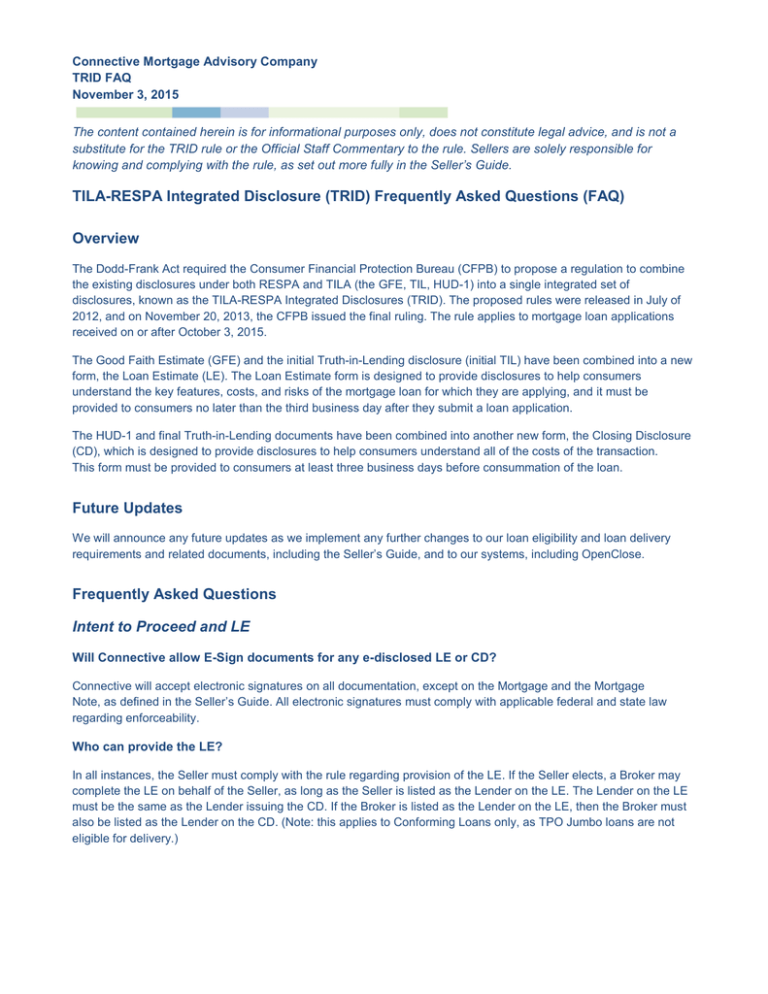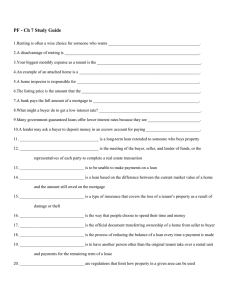
Connective Mortgage Advisory Company
TRID FAQ
November 3, 2015
The content contained herein is for informational purposes only, does not constitute legal advice, and is not a
substitute for the TRID rule or the Official Staff Commentary to the rule. Sellers are solely responsible for
knowing and complying with the rule, as set out more fully in the Seller’s Guide.
TILA-RESPA Integrated Disclosure (TRID) Frequently Asked Questions (FAQ)
Overview
The Dodd-Frank Act required the Consumer Financial Protection Bureau (CFPB) to propose a regulation to combine
the existing disclosures under both RESPA and TILA (the GFE, TIL, HUD-1) into a single integrated set of
disclosures, known as the TILA-RESPA Integrated Disclosures (TRID). The proposed rules were released in July of
2012, and on November 20, 2013, the CFPB issued the final ruling. The rule applies to mortgage loan applications
received on or after October 3, 2015.
The Good Faith Estimate (GFE) and the initial Truth-in-Lending disclosure (initial TIL) have been combined into a new
form, the Loan Estimate (LE). The Loan Estimate form is designed to provide disclosures to help consumers
understand the key features, costs, and risks of the mortgage loan for which they are applying, and it must be
provided to consumers no later than the third business day after they submit a loan application.
The HUD-1 and final Truth-in-Lending documents have been combined into another new form, the Closing Disclosure
(CD), which is designed to provide disclosures to help consumers understand all of the costs of the transaction.
This form must be provided to consumers at least three business days before consummation of the loan.
Future Updates
We will announce any future updates as we implement any further changes to our loan eligibility and loan delivery
requirements and related documents, including the Seller’s Guide, and to our systems, including OpenClose.
Frequently Asked Questions
Intent to Proceed and LE
Will Connective allow E-Sign documents for any e-disclosed LE or CD?
Connective will accept electronic signatures on all documentation, except on the Mortgage and the Mortgage
Note, as defined in the Seller’s Guide. All electronic signatures must comply with applicable federal and state law
regarding enforceability.
Who can provide the LE?
In all instances, the Seller must comply with the rule regarding provision of the LE. If the Seller elects, a Broker may
complete the LE on behalf of the Seller, as long as the Seller is listed as the Lender on the LE. The Lender on the LE
must be the same as the Lender issuing the CD. If the Broker is listed as the Lender on the LE, then the Broker must
also be listed as the Lender on the CD. (Note: this applies to Conforming Loans only, as TPO Jumbo loans are not
eligible for delivery.)
Will Connective require that a consumer indicate Intent to Proceed with the transaction in any particular
form after the LE has been delivered?
If the Seller has a requirement for a particular type of documentation of Intent to Proceed, then that documentation
should be included in the mortgage loan file delivered. Sellers should ensure they have processes in place to
document the consumer’s Intent to Proceed and should be able to provide evidence of same.
Will Connective require the LE to be signed in each case?
If a signature line is provided on the document, then Connective will require that document to be signed. The Seller
must ensure all signature requirements under TRID are met. If the LE form is signed by the consumer, then the
signature statement must comply with the regulatory requirement.
Will Connective accept loans for which the consumer has waived or modified the seven-business-day
waiting period after receiving the LE, if the consumer has a personal financial emergency that
necessitates consummating the credit transaction before the end of the waiting period?
Due to the uncertain regulatory nature around bona fide personal financial emergencies under TRID, mortgage loan
transactions for which the consumer has waived or modified the LE seven-business-day waiting period are not eligible
for delivery.
CD, Principal Curtailments, and Lender Credits
Will Connective require that the CD be signed in every instance?
If the CD form contains the “Confirm Receipt” signature block, then the FINAL CD form must be signed and dated by
the applicant(s) or borrower(s) to whom it was delivered, and the signed form must be included in the mortgage loan
file delivered. If no signature block is printed on the CD, then no applicant signature is required.
Will Connective accept loans for which the consumer has waived or modified the three-business-day
waiting period?
Due to the uncertain regulatory nature around bona fide personal financial emergencies under TRID, mortgage loan
transactions for which the consumer has waived or modified the CD three-business-day waiting period are not eligible
for delivery.
How will Connective deal with APR variances in which the APR decreases by more than ⅛ percent (oneeighth of 1 percent)?
Sellers should always follow Truth in Lending and any guidance put out by the CFPB regarding APR issues. That
being said, it is our understanding that in situations in which the APR increases (not decreases) beyond the regulatory
tolerance, Connective will require that a new CD be issued to the consumer and the new three-business-day waiting
period will apply.
Will Connective permit the settlement agent to provide the property seller with a separate disclosure?
If a separate CD or HUD-1-like closing statement (or any other similar disclosure) is provided to the property seller, we
require both the disclosure provided to the consumer AND the disclosure provided to the property seller to be included
in the delivered mortgage loan file.
How will Connective deal with post-consummation corrected CDs, including changes to amounts paid
by the consumer?
If a Seller identifies, within 30 calendar days of consummation, an event in connection with the settlement whereby the
CD becomes inaccurate and the inaccuracy results in a change to an amount actually paid by the consumer, then the
Seller must provide the consumer a corrected CD within 30 calendar days. Per TRID, if the CD contains non-numeric
clerical errors, the Seller can provide a corrected CD no later than 60 days after consummation.
Will Connective permit principal curtailments for loans where any TRID variance is cured via a curtailment?
Yes. Even though the Seller’s Guide prohibits principal curtailments, if the curtailment is due to a refund to cure a
TRID variance, then it is permitted. The Seller’s Guide will be updated to reflect this position at the end of 2015.
Does Connective require a lender credit itemization?
Previously, Connective did not explicitly require any particular document outlining how lender credits were allocated.
However, for loans subject to TRID, Sellers should provide a lender credit itemization whenever possible in order to
minimize any follow up questions regarding allocation.
© 2015 Connective Mortgage Advisory Company. All rights reserved. Connective Mortgage Advisory Company is a wholly owned subsidiary
of United Guaranty Corporation, an AIG company.
MC-2-A1392-1115




